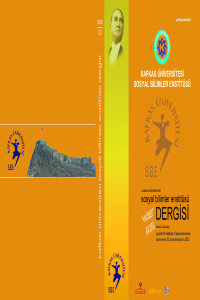Öz
1959-1968 yılları arasında Çin Halk Cumhuriyeti Devlet Başkanı olarak görev yapan Liu Şaoçi’ye yönelik Çin Kültür Devrimi (ÇKD) sürecinde propaganda posterleri etkin bir şekilde kullanılarak yoğun bir itibarsızlaştırma propagandası gerçekleştirilmiştir. Liu, itibarsızlaştırılma propagandasında nefret söylemine ve ağır suçlamalara maruz kalmış ve 1969 yılında hayatını kaybetmiştir. 1980 yılında Liu’nun itibarı iade edilmiş, kendine atfedilen çeşitli olumsuz sıfatlar kaldırılmış ve kendisi için ulusal anma töreni düzenlenmiştir. Liu’ya yönelik gerçekleştirilen itibarsızlaştırma propagandası, ÇKD sürecindeki en önemli nefret suçlarından biri olarak ön plana çıkmıştır. Bu dönemde Liu’ya yönelik yapılan itibarsızlaştırma propagandasının ortaya konulması, ÇKD sürecinde Liu’ya karşı gerçekleştirilen nefret suçuna ışık tutulması bakımından önem taşımaktadır. Çalışmada Liu’nun itibarsızlaştırma propagandasında kullanılan posterler incelenerek, Liu’ya yönelik gerçekleştirilen nefret suçunun tespit edilmesi amaçlanmıştır. Bu amaçla çalışma kapsamında Uluslararası Sosyal Tarih Enstitüsü'nden (Internationaal Instituut voor Sociale Geschiedenis, IISG) ulaşılan Liu’ya yönelik itibarsızlaştırma propagandasında kullanılan sekiz propaganda posteri, Charles Sanders Peirce’in göstergebilim kavramları üzerinden analiz edilmiştir. Çalışmada Liu’ya yönelik itibarsızlaştırma propagandasında çeşitlik ideolojik mesajlar ve suçlamalar üzerinden Çin halkının Liu’ya karşı nefret duymasının ve aynı zamanda Liu’ya karşı harekete geçmesinin teşvik edilmesine çalışıldığı bulguları elde edilmiştir. Böylece çalışma kapsamında Liu’ya yönelik itibarsızlaştırma propagandasının ideolojik temeller üzerinden nefret suçu haline getirildiği sonucuna ulaşılmıştır.
Anahtar Kelimeler
Propaganda Çin Komünist Partisi Nefret Suçu Çin Halk Cumhuriyeti Çin Kültür Devrimi
Kaynakça
- Mason, G. (2005). Hate crime and the image of the stranger. British Journal of Criminology, 45(6), 837-859.
- Mason, G. (2009). Hate crime laws in Australia: Are they achieving their goals?. Criminal Law Journal, 33(6), 326-340.
- Müller, K. & Schwarz, C. (2021). Fanning the flames of hate: Social media and hate crime. Journal of the European Economic Association, 19(4), 2131-2167.
- Perry, B. (2002). Defending the color line: Racially and ethnically motivated hate crime. American Behavioral Scientist, 46(1), 72-92.
- Perry, B. (2014). Gendered Islamophobia: Hate crime against Muslim women. Social Identities, 20(1), 74-89.
- Phillips, N. D. (2009). The prosecution of hate crimes: The limitations of the hate crime typology. Journal of Interpersonal Violence, 24(5), 883-905.
- Ryan, M. E. & Leeson, P. T. (2011). Hate groups and hate crime. International Review of Law and Economics, 31(4), 256-262.
- Türk, M. S., Avcı, Ö. & Baytimur, T. (2021). Çin Halk Cumhuriyeti’nde Sovyet Revizyonizmi’ne karşı kitapların propaganda amaçlı kullanımı. Türk Kütüphaneciliği, 35(2), 159-182.
- Vera Santos, R. E. (2021). Hate crime and racial discrimination in Ecuador: The case of Michael Arce in ESMIL. International Journal of Discrimination and the Law, 21(2), 117-138.
- White, R. & Perrone, S. (2001). Racism, ethnicity and hate crime. Communal /Plural: Journal of Transnational & Cross-Cultural Studies, 9(2), 161-181.
The Hate Crime Against Liu Shaoqi in the Political Discrediting Propaganda of the Chinese Cultural Revolution
Öz
An intense discrediting propaganda was made against Liu Shaoqi, who served as the President of the People's Republic of China between 1959 and 1968, by using propaganda posters effectively during the Chinese Cultural Revolution (CCR). Liu was subjected to hate speech and heavy accusations in discrediting propaganda and died in 1969. In 1980, Liu was discredited, various negative adjectives attributed to him were removed, and a national memorial service was held for him. The discrediting propaganda against Liu came to the fore as one of the most important hate crimes in the CCR process. Revealing the discrediting propaganda made against Liu during that period is important in terms of shedding light on the hate crime committed against Liu during the CCR process. In the study, it was aimed to determine the hate crime against Liu by examining the posters used in Liu's discrediting propaganda. For this purpose, eight propaganda posters used in the propaganda of discrediting Liu, reached from the International Institute of Social History (Internationaal Instituut voor Sociale Geschiedenis, IISG) within the scope of the study, were analyzed through the semiotic concepts of Charles Sanders Peirce. In the study, it was found that in the propaganda of discrediting Liu, it was sought to encourage the Chinese people to hate Liu and also to take action against Liu through various ideological messages and accusations. Thus, within the scope of the study, it was concluded that the discrediting propaganda against Liu was turned into a hate crime on ideological grounds.
Anahtar Kelimeler
Propaganda Chinese Communist Party Hate Crime People Chinese Cultural Revolution
Kaynakça
- Mason, G. (2005). Hate crime and the image of the stranger. British Journal of Criminology, 45(6), 837-859.
- Mason, G. (2009). Hate crime laws in Australia: Are they achieving their goals?. Criminal Law Journal, 33(6), 326-340.
- Müller, K. & Schwarz, C. (2021). Fanning the flames of hate: Social media and hate crime. Journal of the European Economic Association, 19(4), 2131-2167.
- Perry, B. (2002). Defending the color line: Racially and ethnically motivated hate crime. American Behavioral Scientist, 46(1), 72-92.
- Perry, B. (2014). Gendered Islamophobia: Hate crime against Muslim women. Social Identities, 20(1), 74-89.
- Phillips, N. D. (2009). The prosecution of hate crimes: The limitations of the hate crime typology. Journal of Interpersonal Violence, 24(5), 883-905.
- Ryan, M. E. & Leeson, P. T. (2011). Hate groups and hate crime. International Review of Law and Economics, 31(4), 256-262.
- Türk, M. S., Avcı, Ö. & Baytimur, T. (2021). Çin Halk Cumhuriyeti’nde Sovyet Revizyonizmi’ne karşı kitapların propaganda amaçlı kullanımı. Türk Kütüphaneciliği, 35(2), 159-182.
- Vera Santos, R. E. (2021). Hate crime and racial discrimination in Ecuador: The case of Michael Arce in ESMIL. International Journal of Discrimination and the Law, 21(2), 117-138.
- White, R. & Perrone, S. (2001). Racism, ethnicity and hate crime. Communal /Plural: Journal of Transnational & Cross-Cultural Studies, 9(2), 161-181.
Ayrıntılar
| Birincil Dil | Türkçe |
|---|---|
| Konular | İletişim Çalışmaları |
| Bölüm | Araştırma Makaleleri |
| Yazarlar | |
| Yayımlanma Tarihi | 19 Aralık 2023 |
| Yayımlandığı Sayı | Yıl 2023 Sayı: 32 |


